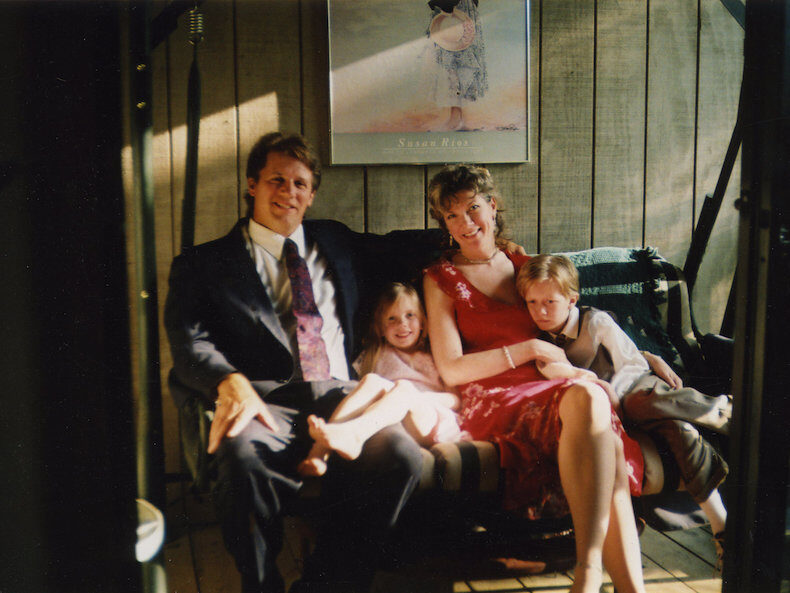 |
| One of the families featured in A Dangerous Son (Source: HBO)
[image: A white family of four, with two young kids, on a couch together.] |
Kit Mead
Content note: Discusses violence and abuse regarding children with mental illness and disability, and the Newtown shootings.
I’m not going to watch “A Dangerous Son,” the HBO documentary that tells “a story about families with children who have psychiatric disorders that lead to violent behavior.” I’m going to avoid it mostly because I have already read all of those stories. Again. And again. And again.
And I have found them incredibly disturbing each time—on behalf of the children who are being written off and exploited. Especially because, as Mel Baggs points out: Across violent and abusive sets of environments, we—the kids—are the only ones seen as having a violence problem.
And those environments are so very often the context for “violent outbursts.” Like mine.
People considered sending me to a school for kids with behavioral problems, after therapy and medication didn’t work to quell my outbursts. Because they were going after the wrong thing: It must, the psychiatrist said, be Oppositional Defiant Disorder and anxiety. Not trauma. Not communication barriers. Not what was modeled as social behavior. Just that I was a rebellious, insolent, violent kid.
A throw-away diagnosis. A throw-away kid.
And I already know the kinds of things they’re going to talk about in the documentary: Parents saying we are desperate, at our wit’s end, we’re scared of our so, so very violent and mentally ill kid. But we’re out of treatment options. The psychiatric hospital is out of beds.
. . .
It’s possible to advocate for and with children who are struggling and vulnerable with some level of dignity, as I have pointed out before, some level of dignity. According to NPR, the director of the film “wanted to show how challenging this situation is both for the child and the family. Often, people assume a child’s behavior is a type of parental failure.” Further, director Liz Garbus told NPR, “Destigmatizing families like Stacy’s who are going through this and seeing how hard they’re trying is really important.”
Well, yes, in part it often is a parental failure, along with the psychiatric industry and other adults in the children’s lives. Whether it is directly perpetuating abuse and violence, enabling it, or failing to recognize the abuse and trauma, it is a failure of adults in their lives. You know what else is a parental and societal failure? Filming kids at their most vulnerable as a way to showcase how “challenging” it is.
You know what’s really important?
Not, as the NAMI spokesperson in the NPR article implies, framing it as a choice between psychiatric beds and intractable violence at home. Because it does not surprise me and my friends that one of the kids’ behavior “didn’t improve” when he got home from inpatient. Because we have witnessed the violence and hostility of inpatient institutions.
Maybe a focus on trauma-informed care and removing sources of abuse and violence in the kid’s life. Maybe that’s also important. Maybe it’s important to fight for community-based services and training providers need instead of more psych beds.
It’s possible to advocate for struggling children with dignity.
. . .
After the Newtown shootings and a particularly bad Gawker article called I am Adam Lanza’s Mother—written by a parent about her 13-year-old son—Savannah Logsdon-Breakstone wrote an article describing being one of the “scary kids,” the right to privacy, and the dangerous assumptions and dismissals people make. Every word of the piece is important, but here is a snippet:
“My mother doesn’t regret keeping it private, between her and her private journal or her therapist. Today she was at a consumer and family advisory for our behavioral health managed care organization (BHMCO). They read that Gawker article, and my mother was appalled. She has scary stories about me, but the idea of sharing them in a way that associated them publicly with me was a horrifying violation of privacy and good sense to her. She was struck by the negativity of the piece, of the author. And she noticed how it relies on and perpetuates stigma, and jumps to conclusions.
“Having been one of those scary kids is scary… What made it scary to have been one is what people assume based on it — and what they assume when you don’t disclose.”
I Am Adam Lanza’s Mother inspired A Dangerous Son. The author is featured in the movie.
. . .
And what if filmmakers had turned a camera on me capture my worst moments? Then what? Would anyone have seen the context? Would anyone have seen a vulnerable child? Would anyone have stopped to think about the young person whose future they’re so willing to damage? What this might do to them on every level of being?
No. They wouldn’t have, because it’s already happened, over and over again, to others. They chose to exploit. But they could have provided sensitivity and trauma-informed care to a young, struggling person instead.
However lost in life you may think we are: “None of us are lost causes.”